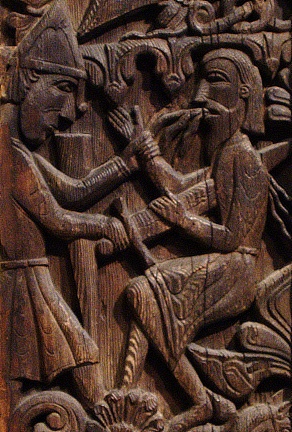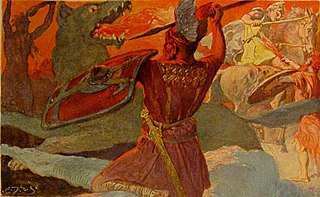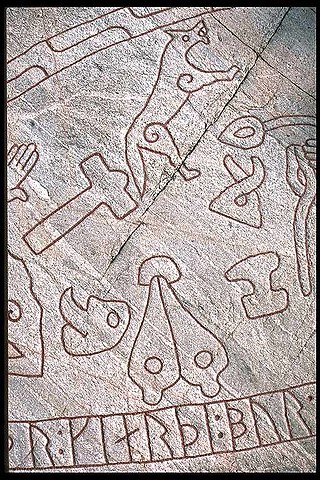Norse mythology includes a diverse array of people, places, creatures, and other mythical elements.
Norse mythology includes a diverse array of people, places, creatures, and other mythical elements.
Many dwarfs are named in the poem Völuspá and repeated in Gylfaginning [1]

The Norns are deities in Norse mythology responsible for shaping the course of human destinies.

The Völsunga saga is a legendary saga, a late 13th-century poetic rendition in Old Norse of the origin and decline of the Völsung clan. It is one of the most famous legendary sagas and an example of a "heroic saga" that deals with Germanic heroic legend.

In Norse mythology, Reginn is a son of Hreiðmarr and the foster father of Sigurð. His brothers are Fáfnir and Ótr.
In Norse mythology, Hreiðmarr is a sorcerer. He is featured in the Völsunga saga and in Snorri Sturluson's Prose Edda.

In Germanic heroic legend and folklore, Fáfnir is a worm or dragon slain by a member of the Völsung family, typically Sigurð. In Nordic mythology, he is the son of Hreiðmarr, and brother of Regin and Ótr and is attested throughout the Völsung Cycle, where, Fáfnir slays his father out of greed, taking the ring and hoard of the dwarf Andvari and becoming a worm or dragon. Fafnir's brother Regin later assisted Sigurð in obtaining the sword Gram, by which Fáfnir is killed. He has been identified with an unnamed dragon killed by a Völsung in other Germanic works including Beowulf, the Nibelunglied and a number of skaldic poems. Fáfnir and his killing by Sigurð are further represented in numerous medieval carvings from the British Isles and Scandinavia, and a single axe head in a Scandinavian style found in Russia. The story of Fáfnir has continued to have influence in the modern period, such as in the works of J.R.R Tolkien, who drew inspiration from the tale of Fáfnir in his portrayals of Smaug and Gollum.

In Norse mythology, Andvaranaut, first owned by Andvari, is a magic ring that could help with finding sources of gold.
In Norse mythology, Dvalinn is a dwarf (Hjort) who appears in several Old Norse tales and kennings. The name translates as "the dormant one" or "the one slumbering". Dvalinn is listed as one of the four stags of Yggdrasill in both Grímnismál from the Poetic Edda and Gylfaginning from the Prose Edda.

In Norse mythology, Vígríðr or Óskópnir is a large field foretold to host a battle between the forces of the gods and the forces of Surtr as part of the events of Ragnarök. The field is attested in the Poetic Edda, compiled in the 13th century from earlier traditional material, and in the Prose Edda, written by Snorri Sturluson in the 13th century. The Poetic Edda briefly mentions the field as where the two forces will battle, whereas the Prose Edda features a fuller account, foretelling that it is the location of the future death of several deities before the world is engulfed in flames and reborn.

In Norse mythology, Gram, also known as Balmung or Nothung, is the sword that Sigurd used to kill the dragon Fafnir. It is primarily used by the Völsungs in the Volsunga Saga. However, it is also seen in other legends, such as the Thidrekssaga in which it is wielded by Hildebrand.

In Scandinavian heroic legend, Grani is a horse owned by the hero Sigurd. He is the horse that Sigurd receives through advice from the Norse god (Odin). Grani is a descendant of Odin's own steed, Sleipnir.

In Norse mythology, Ótr is a dwarf. He is the son of the king Hreidmar and the brother of Fafnir and Regin.

In Abrahamic and European mythology, medieval literature and occultism, the language of the birds is postulated as a mystical, perfect divine language, Adamic language, Enochian, angelic language or a mythical or magical language used by birds to communicate with the initiated.

Dragons, or worms, are present in Germanic mythology and wider folklore, where they are often portrayed as large venomous serpents. Especially in later tales, however, they share many common features with other dragons in European mythology.

The Salmon of Knowledge is a creature in the Fenian Cycle of Irish mythology, sometimes identified with Fintan mac Bóchra, who was known as "The Wise" and was once transformed into a salmon.
Riðill or Refil is a sword that appears in Norse Mythology, possessed by the dwarf Regin.

The Sigurd stones form a group of eight or nine Swedish runic inscriptions and one picture stone that depict imagery from the Germanic heroic legend of Sigurd the dragon slayer. They were made during the Viking Age and constitute the earliest Norse representations of the matter of the Völsung cycle that is the basis of the Middle High German Nibelungenlied and the Sigurd legends in the Poetic Edda, the Prose Edda, and the Völsunga saga.

Sigurd or Siegfried is a legendary hero of Germanic heroic legend, who killed a dragon - known in some Old Norse sources as Fáfnir - and who was later murdered. It is possible he was inspired by one or more figures from the Frankish Merovingian dynasty, with Sigebert I being the most popular contender. Older scholarship sometimes connected him with Arminius, victor of the Battle of the Teutoburg Forest. He may also have a purely mythological origin. Sigurd's story is first attested on a series of carvings, including runestones from Sweden and stone crosses from the British Isles, dating from the eleventh century.

The Story of Sigurd the Volsung and the Fall of the Niblungs (1876) is an epic poem of over 10,000 lines by William Morris that tells the tragic story, drawn from the Volsunga Saga and the Elder Edda, of the Norse hero Sigmund, his son Sigurd and Sigurd's wife Gudrun. It sprang from a fascination with the Volsung legend that extended back twenty years to the author's youth, and had already resulted in several other literary and scholarly treatments of the story. It was Morris's own favorite of his poems, and was enthusiastically praised both by contemporary critics and by such figures as T. E. Lawrence and George Bernard Shaw. In recent years it has been rated very highly by many William Morris scholars, but has never succeeded in finding a wide readership on account of its great length and archaic diction. It has been seen as an influence on such fantasy writers as Andrew Lang. The Story of Sigurd is available in modern reprints, both in its original form and in a cut-down version, but there is no critical edition.
The Hylestad Stave Church was a stave church located in Hylestad, Setesdal district, Norway. The church was estimated to have been built in the late 12th to the early 13th century and was demolished in the 17th century. Some of the intricate wood carvings from the church doorway were saved and incorporated into other buildings. They are now on display at the Museum of Cultural History in Oslo.

The Helm of Awe or Helm of Terror is an object in Norse mythology and subsequently the name of an Icelandic magical stave. The symbol used for the reference in the sagas came from the Huld manuscript written and collected in 1847, and has no previous attestations. The symbol was used as a part of a Christian magic ritual that may have had some movements rooted in Icelandic culture, but was very common ritualistic practice across Christendom.